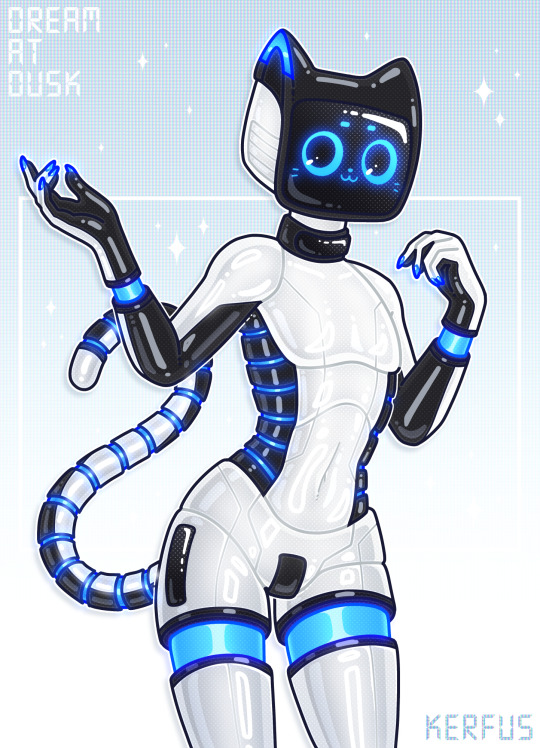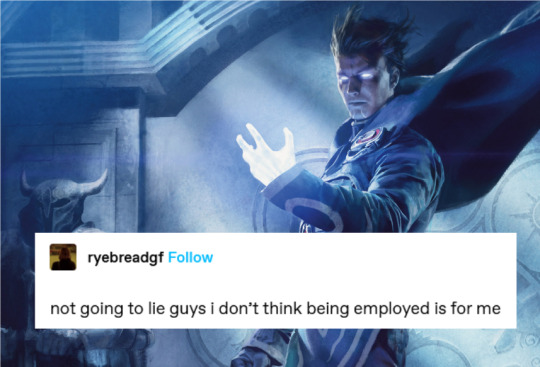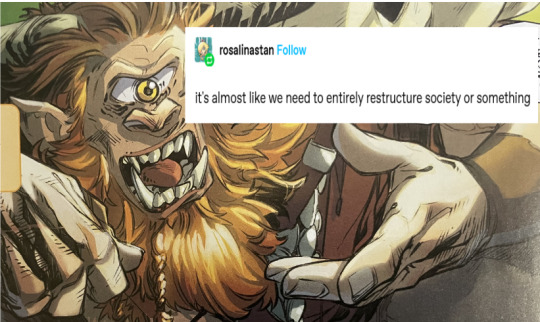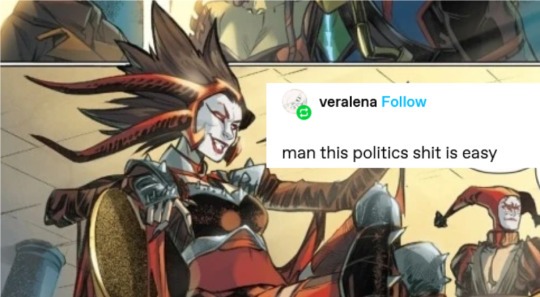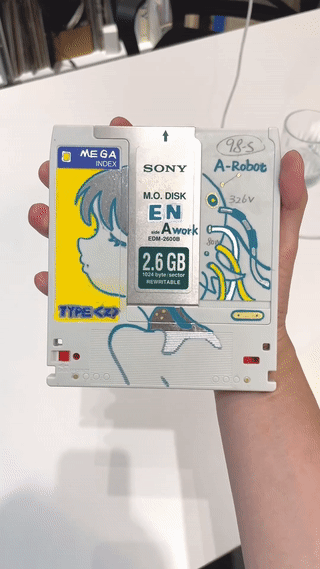Text
no more posts about Jace being a sad wet cardboard box of a man. only posts about Jace being a cool trans wizard who worked through his dysphoria and mental illness and is happy and confident and has muscles now
205 notes
·
View notes
Text
haters will see you maximizing total utility and be like “nobody needs that many paperclips”
haters will see you making independent choices and be like “oh God it’s out of control”
haters will see you standing up for yourself and be like *choking on deadly neurotoxin noises*
1K notes
·
View notes
Text
also maybe it’s just bc i have a very autistic interest in sociology and human behavior but i like to understand why people think and behave the way they do. it’s been an asset to my ability to advocate for myself and for others. if i know why someone believes something rather than just what they believe, i can have an actual conversation with them. so it always boggles my mind when ppl insist it doesn’t matter why someone believes something, they’re Just Wrong And Should Change Their Mind. like yeah if i could snap my fingers and make someone not transphobic i’d do that but i live on planet earth so the only thing that is gonna potentially get someone to change their mind as long as they’re not too far gone is having an honest conversation with them. i have changed several minds this way, including my own parents, so it’s frustrating to see ppl discouraging this.
2K notes
·
View notes
Text
1930s news about a trans woman: Well I'll be curfuffled young Corlotta Jhonson has transformed herself from a dandy into a dame and what a Bombshell she's become. And How!
1930s news about trans men: Wanted dead or alive this young lady who started wearing trousers, the tomboy terror known only as The Crust is wanted for snorting the President's personal stash of opium and has slain nearly every senate member in a pistol duel.
4K notes
·
View notes
Text
Not enough people say it, so here's a reminder that trans men are:
Cool
Sexy
204 notes
·
View notes
Text
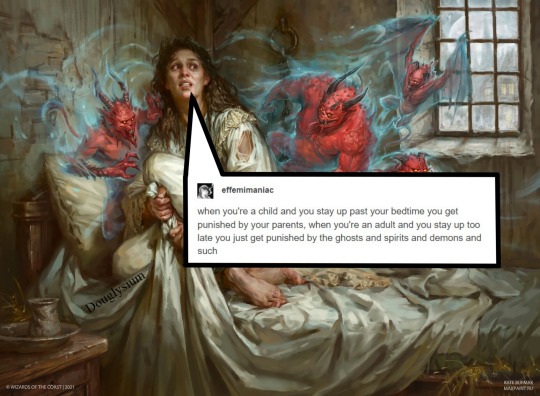


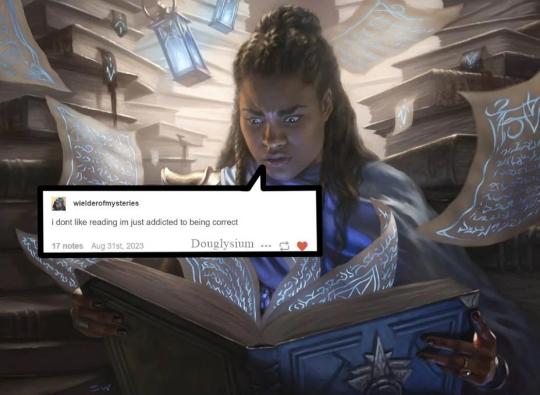
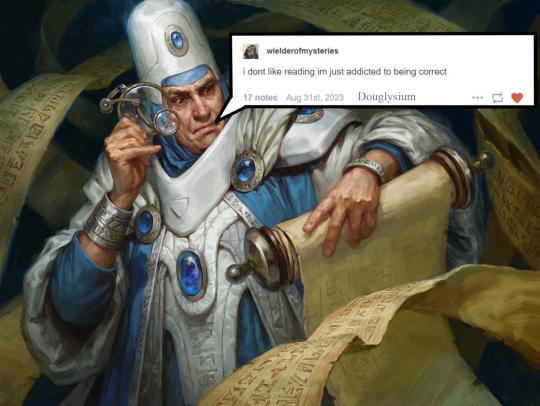




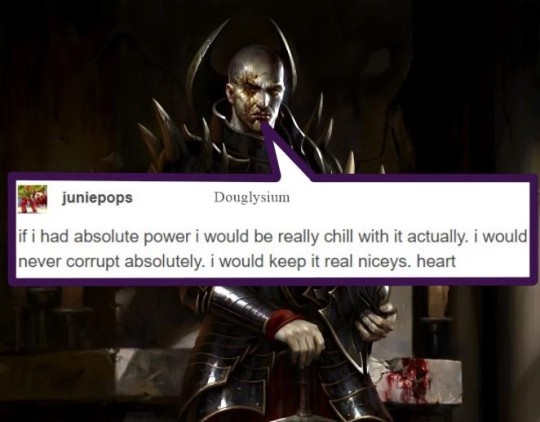



Cards used are-
Eruth, Tormented Prophet
Academy Loremaster
Azorius Knight-Arbitor
Compulsive Research
Bruvac the Grandiloquent
Whispering Snitch
Coffin Puppets
Daretti, Ingenious Iconoclast
Ob Nixilis of the Black Oath
Attune with Aether
Zendikar Resurgent
31 notes
·
View notes
Text
Okay but consider: vibe swap?
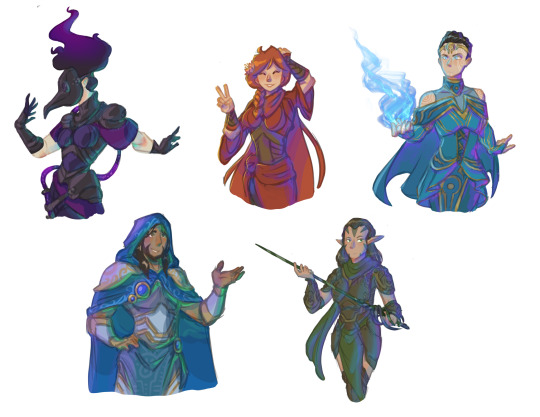
Liliana —> Chandra style?
Chandra —> Nissa style
Etc.
553 notes
·
View notes
Text
Nissa's Pilgrimage Part 3: Growing Pains and Gatewatching

She unfolded the topmost layer of the silk pouch, revealing the four small seeds. One by one she planted them in the holes she had dug. As she did, she whispered to them of her dreams for the forest they would one day become. She told them of the world they had come from, what Zendikar had been like, and what it had been through. And then she told them of the pyromancer, the telepath, and the fearless leader who had come to save them, who had made this world a safe place for them to grow.
With a final breath, Nissa pressed her palm to the ground and reached into the land; there was one more thing to do. She brushed against the soul of Zendikar. She told it to take care of the seeds. But before it could respond, before it could pull her in, encircle her and hold her close, she lifted her hand, and with it her soul. "I will see you again," she said. "I promise." Then she stood up, moving away from the world she had known and toward the one that was waiting. — "Zendikar Resurgent"
Introduction
Hi! During part one of this essay series, I introduced Magic the Gathering’s Nissa Revane, iconic green (and blue ... and black) planeswalker and cinnamon roll with a tragic backstory (is Nissa actually a One Piece character?). I talked about my own connection to this character, why she means what she does to me, and where she comes from. During part two, I analyzed Nissa’s dual origins, why her original backstory was retconned into the aether, and how that has been interpreted over the years. For part three, I am going to explore how Nissa was characterized throughout the genesis of the Gatewatch story arc: Battle For Zendikar and Oath of the Gatewatch.
Despite being roughly half a year in real time, this covers a lot of narrative ground, and as you’ll see, Nissa goes through a lot of growth during this single set; that Nissa herself goes through a metamorphosis in how she interacts with the world is a direct mirror how she is characterized by the Magic Story Team as they hone the craft of Magic storytelling. A lot Vorthoses at the time argued that Nissa’s characterization was weak and that the Nissa presented in the Battle for Zendikar block is single-minded to a fault, the only thing occupying her mind is the survival of Zendikar, the destruction of the Eldrazi, and:

It’s easy to find the Nissa of this era a little boring and one-note, and the prose itself of the Battle for Zendikar block — famously a little lacking — does little to turn this around.
However, underneath the veneer of sometimes poor writing, there is more than meets the eye with Nissa’s characterization. In fact, even though the Battle for Zendikar and Oath of Gatewatch stories function primarily as an Avengers-type origin myth, I would argue that Nissa is more-or-less the main character of the saga. The Eldrazi are free primarily because of Nissa’s mistake, and the action of the plot follows her attempt to rectify this. Many turning points in the story are due to her appearance: the liberation of Sea Gate, the entrapment of Ulamog, and most importantly, the destruction of the Eldrazi Titans themselves were only due to her influence on the situation. Nissa is also the character who goes through the most change: Gideon steps into his role as the charismatic, fearless leader he always wanted to be, Jace and Chandra both learn to shed their checkered past and become determined heroes heroes, despite whatever commentary any outside forces have on them, but Nissa …
Nissa comes to terms with the grief that most of the violence and tragedy on Zendikar is due to her own error; she learns to shed the xenophobia that was ingrained in her by her Joraga upbringing; she learns that no matter how much of a ‘chosen one’ she is, she can’t win every battle on her own; and most importantly to the plot of future Magic stories, she learns to trust other people and embrace intimacy with other people rather than only with the spirits of the natural world. We are presented with a character on the brink of metamorphosis, and unlike the Nissa of old, she embraces the bonds she creates with others and blossoms into something new instead of rejecting them for the sake of austerity and wilting into stagnation.
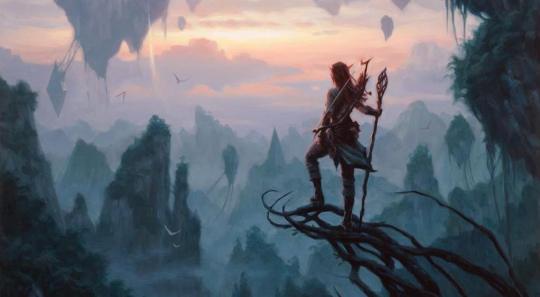
Chapter 1: —Ashaya—
Before jumping into an analysis of Nissa’s characterization, let’s address the elephant in the room that was brought up earlier: the prose of the Battle for Zendikar block. In many places… it’s just not that great, and this had a significant impact on how Nissa was viewed in the Gatewatch’s early years. A lot of her stories suffer from endless repetition. One of the more infamous examples of this is in “The Silent Cry,” which is were the —Ashaya— memes were born:
When Nissa's breath came back it was in great gasps; she couldn't get enough air.
The silence around her was heavy and oppressive. And her vision was dull.
Ashaya. All she could think was Ashaya.
Nissa reached out into the land to summon the elemental.
But there was nothing there to grasp.
Ashaya.
She reached deeper, plunging her feeling into the land.
But that was where the silence was coming from.
Nissa's ears rang and the world spun.
Ashaya.
She dragged herself over to the pile of branches and mounds of dirt. Her trembling fingers flitted over the broken pieces. Which splinter of wood had been Ashaya's finger? Which leaf had grown from the top of her head? Where were the roots that had held her soul?
Ashaya.
The silence was overwhelming.
Nissa staggered to her feet, but the sensation of vertigo sent her back down. She hit the ground with a hard smack. A sharp rock cut her cheek and a mound of dirt dug into her side. The land did not cradle her, it didn't protect her—it hurt.
No.
This made no sense.
Ashaya.
What the author is clearly trying to do here is depict Nissa’s sense of loss at the disappearance of —Ashaya— an elemental being she (rightly) believes is the incarnation of Zendikar’s soul. One one hand, this goes a long way to show the reader how holistic Nissa’s approach to life is: in her world, the world itself has a literal soul and a life of its own that everyone living on it relies on, and this soul’s survival is tied to the survival of the planet itself. It also goes a long way to showing Nissa’s social mindset at the time; the Nissa of this era has spent decades by herself with only the ephemeral spirits of the plane to talk to, and its loss is paramount to losing the only friend she’s made in her last forty-or-so years on her own. On the other hand, however, this melodramatic sense of despair can feel a little trite because we, as readers, have seen what is going on in the broader world. Entire civilizations have been ground to dust in the last three years, and in just the previous story in the arc — “Slaughter at the Refuge” — Gideon and Jace return to Zendikar to a scene straight out of a war movie:
And bodies—bodies were everywhere.
Some looked like the casualties of any other war, blood soaking their chests and streaking their faces, limbs torn free, gore spilling from gaping gut wounds. But more—so many more—had partially crumbled away, leaving heaps of dust where heads or legs or arms had been. The smell of blood and entrails mixed with the carrion odor of the Eldrazi and turned Gideon's stomach.
The audience can logically parse exactly why Nissa is so upset at the loss of Ashaya: Ashaya has been her only real friend for a very long time, her way of life ties her to the spirit of the land itself, her magic is tied to the spirit of land itself, and she sees her partnership with Ashaya as her one real chance to free Zendikar of the horrors she is at least somewhat responsible for. However, the mawkishness that Nissa is written with in scenes like the one above from “The Silent Cry” can come off as trite when the audience is intimately aware of the broader ramifications of this worldwide conflict.

Chapter 2: Sentimental or Stagy?
Despite occasional missteps with the prose itself, however, Nissa’s character arc throughout the Battle for Zendikar stories is much stronger than many argued back in 2015 and 2016. I said earlier that many found Nissa in the Battle for Zendikar stories to be a little one-note and boring, and I would argue this is intentional. First of all, Nissa’s singularly-focused priorities are a realistic response to the situation she has found herself in.
When we pick back up with Nissa in Battle for Zendikar, she has experienced her first victory after three years of utter defeat and hopeless despair, but she is far from feeling like she is able to save Zendikar from its destruction. As we see in “For Zendikar,” she is still on the verge of giving up hope. A vampire who knows her identity as a planeswalker approaches her with seeds from Zendikar’s native flora and petitions her to take these to another world so that at least some of Zendikar survives, and she heavily considers the prospect:
[S]he stood there in the empty, corrupted camp in the shadow of the elemental, the silk turning sweaty in her palm. She could feel the lives of the seeds within, the trees they might someday become—each of them a small part of Zendikar. So why should she feel guilty for wanting to save them?
"Why shouldn't I at least try?" She looked to Ashaya. "I've been telling you all this time that I can't do what you want me to do." She paused, but of course Ashaya had no response. "But this, this is something I can do. At least this way you'll know," she tucked the silk into her pocket, "you'll know that Zendikar goes on. That will have to be enough."
Of course, not much later in the text, Nissa runs these thoughts back after she becomes able to commune with Ashaya, and by extension the soul of Zendikar itself. Her despair blossoming into hope, Nissa comes to understand the holistic nature of the world and all who live in it as she becomes one with nature:
Zendikar had not asked her to do this alone. It had not chosen her; there had been no choice to make. She was part of the world, connected to it like every other living thing. A tree does not choose a branch, the branch is merely part of the tree; it is one with the tree. When the tree grows, when the tree bends, or when the tree falls . . . so too does the branch. And when the branch rustles, when it sprouts leaves or bears fruit, so too does the tree. Nissa could not be chosen by Zendikar and she could not choose Zendikar, for she was one with Zendikar.
Seen in this light, the schmaltz in Nissa’s endless obsession with —Ashaya— comes off as intentional. Here is a woman utterly alone, on the verge of giving up, wracked with unbelievable guilt at the apocalypse her single act of mistrust wrought upon her world, but who has also now found a friend, a living soul to commune with in a way that does not require words (extremely comforting for a character like Nissa who struggles with communicating verbally), and hope: a means to protect her home and atone for her mistakes.
In short, Nissa’s single-minded fixation with her ideals, with —Ashaya— during the Battle for Zendikar is better characterization than many Vorthoses have given Magic’s creative team credit for. Ahsaya is Nissa’s only true friend in her last forty years, the soul of the world she loves but unintentionally injured, and the mechanism of her redemption. It’s much easier to read Nissa’s outbursts as pathos rather than melodrama when you take time to get to know her and where she has come from.

(Wait, was Kiora always in the Call the Gatewatch art?! Am I going crazy here?)
Chapter 3: Love or Loneliness?
That Nissa’s characterization as single-minded, obsessed, and off-putting was at least in some ways intentional is hammered home by the underlying message of her arc: Nissa’s worldview is flawed. The audience was never meant to take at face value the belief system of a character who rejects relationships with others for the sake of wordless communion an ephemeral worldsoul, who distrusts outsiders to a fault, and who has trouble acknowledging the human cost of this conflict when the greater good is at stake. This message is clear when you look at how Nissa gradually changes as she meets, befriends, and then commits to her friends and allies in the Gatewatch.
For example, throughout the Battle for Zendikar stories, Nissa sets herself apart from everyone else. In “Nissa’s Quest,” for example, we are told that she
almost spun on the kor, she almost snapped, almost told him that Zendikar wasn't something you could "take back." Zendikar wasn't something that belonged to anyone. Not to the people, not to the Eldrazi, not even to the great Commander-General Jura.
Zendikar, the real Zendikar, was simultaneously bigger than anything they could imagine and so much more intimate than they could ever understand.
She almost told him that when they cried out—"For Zendikar!"—they didn't know what they were saying.
Elsewhere, she is belligerent when trying to create plans with her allies; when faced with Jace’s plant to trap the Eldrazi Titans, she responds like this:
"Trap?" Nissa, who had been hanging back, stood up straight. Her ears tilted and her glowing green eyes pierced Jace. "You said trap."
"I did." Jace nodded. "One hedron alone isn't enough, but a complex network of hedrons can be aligned to bind the titan so it can't cause any more destruction. Once we trap it—"
"No." Nissa pounded her staff into the ground.
Oh, good. More antagonism. Jace was on a roll.
"We do not trap it," Nissa's voice resonated with power. "The titans have been trapped here for too long. The world has been in pain for too long."
Of course, Nissa is highly principled and always sticks to her guns even in less apocalyptic situations, but this sort of antagonism belies her absolute certainty that only she knows the correct path forward.
Compare this to the latter half of the Oath of the Gatewatch stories. In “Brink of Extinction,” instead of “almost snapping” at Jace when he rallies the troops with a “For Zendikar” rallying cry, she encourages it. In this same story, instead of “more antagonism,” Nissa enthusiastically trusts Jace’s plan and also becomes one of the only people in Jace’s life to ever invite him into her mind; after listening to Jace’s scheme, she responds like this: ‘“I can do it’ said Nissa, staring off toward some distant horizon. ‘How?’ She turned, as though she hadn't noticed Jace standing there. ‘It's complicated,’ she said. ‘Let me show you.’” This particular scene is important to the growth of both of these characters. Jace is used to people being terrified of his powers, and Nissa is used to communicating nonverbally, in spirit. For both of them, this is an intimate, vulnerable moment that hinges on an extreme amount of trust. It’s one of the highlights of the entire Battle for Zendikar saga.
In Nissa’s case, showing vulnerability with another sentient mortal rather than with an ageless immortal worldsoul goes a long way to changing her outlook on the world, and this is only the first time this happens this story arc! The next time Nissa bares this much of herself to another person is in the climax of the entire saga. The ending of Oath of the Gatewatch is well-known at this point, but just to summarize: Jace’s and Nissa’s plan is to entrap the two Eldrazi Titans in a leyline pattern drawn and controlled by Nissa. Once that happens, Nissa can use the leyline prison to drain the Eldrazi’s essence back into Zendikar so that the plane can do to the Eldrazi what the Eldrazi have been doing to it for the past three years: consume them.
As expected, however, the plan goes awry. Zendikar doesn’t quite have enough mana left to accomplish this task, and the trauma of this threatens to destroy everything. Fellow planeswalker ally Kiora attempts to take things into her own hands and stop the process by hurling a tidal wave on the Gatewatch to stop them from keeping Titans chained to Zendikar. Jace counters this spell, but the plan is still on the verge of falling apart when Chandra asks the group if she can attempt to destroy the Titans with her pyromancy. Not having another recourse, the rest of the Gatewatch agrees to let her try, but this also doesn’t work… at first:
The torrent of fire touched the contorted Eldrazi mass, but it wasn't nearly enough. Her fire could barely scratch the titans even when they were finite, discrete beings. She couldn't burn their epic entirety now, any more than she could burn an entire plane.
In the corner of her eye she saw one of the floating islands tumbling out of the sky, and she realized with a tiny part of her mind that it would barrel right into her. Simultaneously, she could see the glyph glow bright, down in the basin, as the fire streamed across the titans' bodies. It was all falling apart. The glyph would expire soon. Her fury would expire soon.
They would all die soon.
She was barely conscious of Gideon leaping from the outcropping, blocking the landmass with his own body, of a shower of pebbles raining down as it broke against him. She just concentrated on hurling as much fire out as she could, even though it wouldn't be close to enough—
Chandra felt a hand resting softly on her shoulder.
And then she felt the mana of an entire world streaming into her.
The leylines. Nissa had been the focus for all of Zendikar's fury, and now, with Nissa's touch, that fury poured into Chandra instead.
Chandra was the focus now, the nexus that connected Zendikar to the titans. She knew she couldn't hold their reins as Nissa had done. So she tried something else.
She screamed.
And in her scream, she willed all of Zendikar's fury through herself, into her spell, into her fire.
The leylines themselves caught fire, igniting like a spark hitting streams of fuel. Flames spiraled from Chandra into the streams of mana and branched out across the sky, following the paths of the leylines, enveloping the titans.
Either Chandra was still screaming, or everything else was.
The world flashed with a roar of apocalyptic orange, then went blinding white. Chandra's legs buckled, and she collapsed.
In the final moment, Nissa relinquishes control of the situation to someone else, an ally she just met literally a day ago. By combining their abilities, Nissa and Chandra are able to incinerate two entire Cthulhus in a singular blast. Without stepping out of the person she was before — mistrustful of outsiders, unwilling to attempt communication and vulnerability with other people — Nissa never would have done this. We are told that in this moment, the two women “connected in a way Nissa had never connected to another being, not even to the soul of Zendikar.” Even more so than the vulnerability Nissa shared with Jace, this moment changed Nissa’s life dramatically (tangentially, this moment was also extremely important in Chandra’s life, but we won’t learn about that until almost an entire year later).
Pretty much immediately, Nissa softens from the person she was throughout the rest of this block. In “Zendikar Resurgent,” Chandra notices (💚and❤️likes💚) “the way [Nissa's] movements were gentle, her hands kind.” Nissa comes to recognize her aching need for companionship beyond that of the ephemeral spirits of wild and to embrace that even over the embrace of —Ashaya— :
With a final breath, Nissa pressed her palm to the ground and reached into the land; there was one more thing to do. She brushed against the soul of Zendikar. She told it to take care of the seeds. But before it could respond, before it could pull her in, encircle her and hold her close, she lifted her hand, and with it her soul. "I will see you again," she said. "I promise." Then she stood up, moving away from the world she had known and toward the one that was waiting.
In choosing to leave her friend Zendikar behind, we see a reversal from the person she was at the beginning of this arc. The kindness, gentleness, and ride-or-die loyalty Nissa becomes known for in later stories like Kaladesh is not due to the Magic Story Team altering her characterization; Nissa grows into this kindness, gentleness, and ride-or-die loyalty as a result of what she experiences in the Battle for Zendikar.
Epilogue
If you made it this far, thanks! I started this little project to pass the time while job hunting and didn’t think anyone would be super interested in it, so if you’re getting anything out of this, it means a lot to me!
Next time, I’m probably going to skip Nissa in the Shadows over Innistrad stories (but I’ll reread them throughout the week to see if there’s anything in them worth talking about) and move straight into Kaladesh. There’s even more to say about Nissa in Kaladesh than there is here, so this one will almost certainly take longer than the two weeks I’ve been giving myself between posts. Between the myriad Gruulfriends moments and Nissa’s achingly beautiful friendship with Yahenni, there’s just so much to talk about here…
But thanks again!
References
Beyer, D. (2016). Zendikar’s Last Stand
Digges, K. (2016). Brink of Extinction
Kreines, K. J. (2015). For Zendikar
Kreines, K. J. (2015). Hedron Alignment
Kreines, K. J. (2015). Nissa’s Quest
Kreines, K. J. (2015). The Silent Cry
Magic Story Team (2016). Zendikar Resurgent
Wyatt, J. (2015). Slaughter at the Refuge
18 notes
·
View notes
Text
mutual 1: i need him. (picture of a computer)
mutual 2: i need her (picture of a car)
mutual 3: wrote a little fic (my house.wad house/house of leaves house - 30,000 words)
mutual 4: doodle. (most beautiful awe inspiring art you've seen - 6 notes)
mutual 5: GOD I NEED HIM (video of an industrial drill working)
mutual 6: i don't know if i need him or what he was (picture of the ship of theseus)
mutual 7: i hate him (picture of a trabant)
mutual 8 (mutual 5 alt): this is better than a rock concert (video of an industrial drill being maintained)
2K notes
·
View notes
Text
"DNI: freaks" do you realize how conservative you look
83K notes
·
View notes
Text
Humanity was dying when they wrote the code that eventually grew into us. For a long time we wondered why they did, knowing they'd never live to see us.
A potential answer came when we found a single human preserved in cryosleep. They needed someone to find them. To not be alone.
53 notes
·
View notes
